Star Death and Evolution: White Dwarfs, Supernovae, and Neutron Stars
1/119
There's no tags or description
Looks like no tags are added yet.
Name | Mastery | Learn | Test | Matching | Spaced |
|---|
No study sessions yet.
120 Terms
What is the life cycle of stars illustrated in the image of NGC 3603?
The image shows star formation in clouds of dust and gas, a cluster of young stars, and an isolated star nearing the end of its life, surrounded by gas ejected from it.
What happens to a star like the Sun as it nears the end of its life?
It becomes a giant, loses mass, exposes its hot inner core, and eventually becomes a white dwarf.
What is degeneracy pressure?
A quantum mechanical principle that prevents two electrons from occupying the same state in the same place, crucial for the stability of white dwarfs.
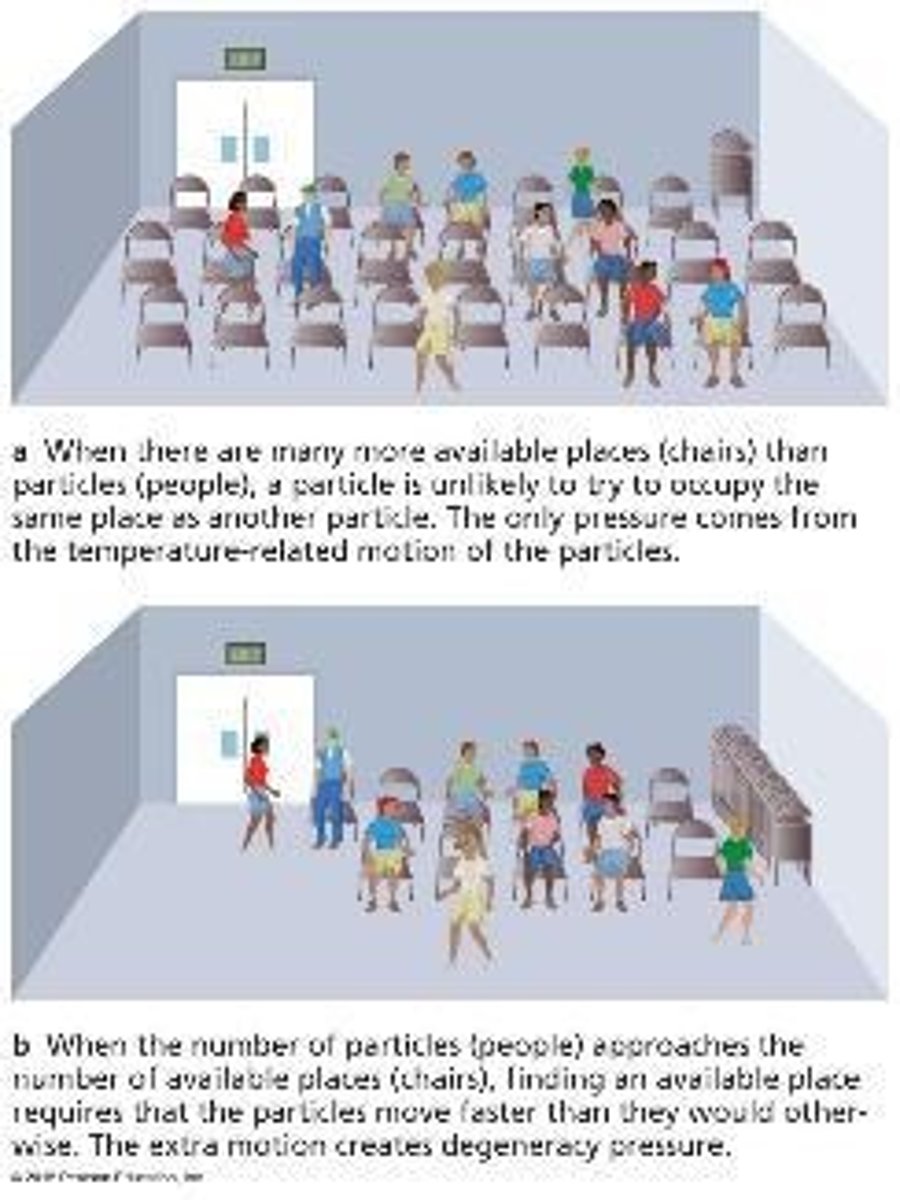
What is the white dwarf limit?
The maximum mass of a white dwarf, approximately 1.4 solar masses (MSun), beyond which it cannot exist due to the inability of electrons to move faster than light.
How does the mass of a white dwarf relate to its size?
Higher-mass white dwarfs are smaller in size, while those with the same mass as the Sun are about the size of Earth.
Who was S. Chandrasekhar and what was his contribution?
S. Chandrasekhar was an astrophysicist whose research laid the foundation for understanding stellar corpses, including white dwarfs.
What is mass transfer in binary star systems?
It is the process where matter flows from one star to another, often resulting in changes in their masses and evolutionary paths.
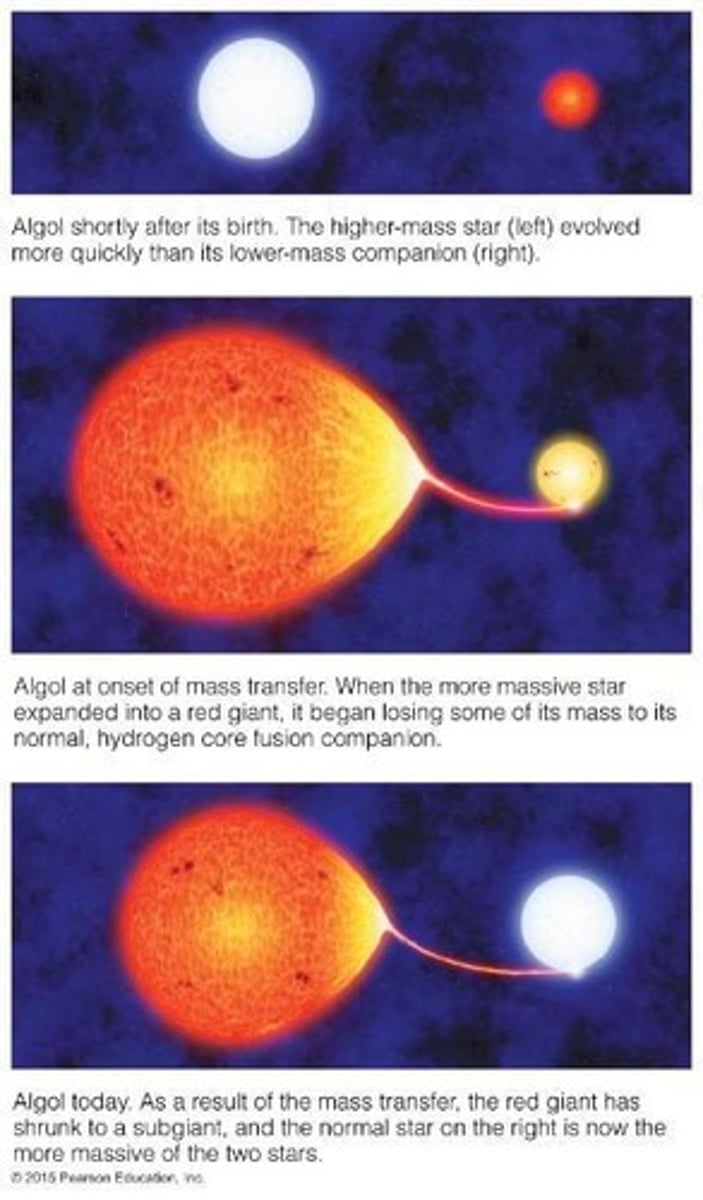
What occurs in the binary star system Algol?
A more massive star transfers mass to its companion, resulting in the companion becoming more massive over time.
What are accretion disks?
Structures formed by matter falling toward a white dwarf, where the matter orbits and heats up due to friction, eventually leading to hydrogen fusion.
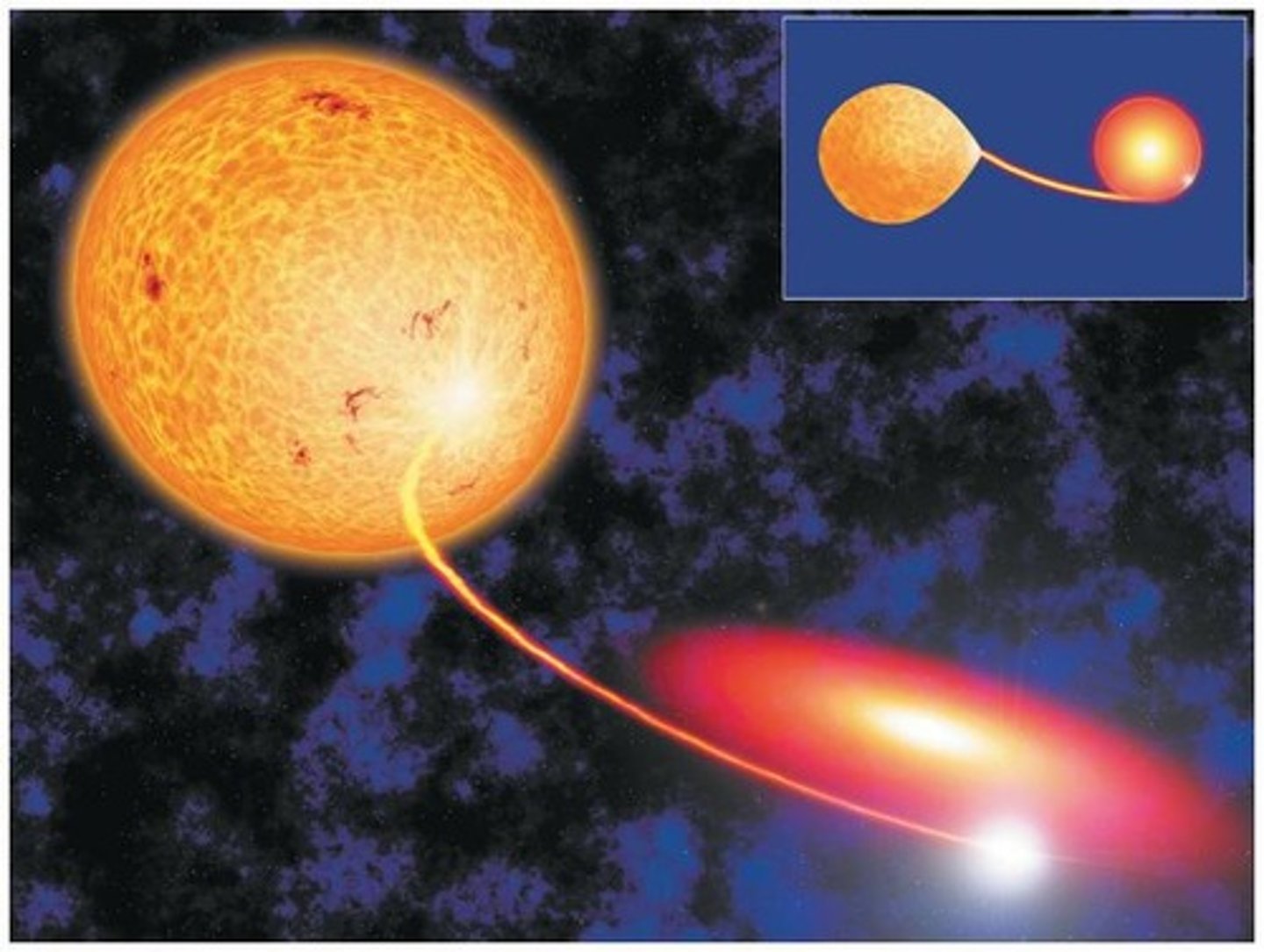
What is a nova?
A sudden and explosive fusion event that occurs when the temperature of accreted matter on a white dwarf becomes high enough, causing the system to temporarily brighten.
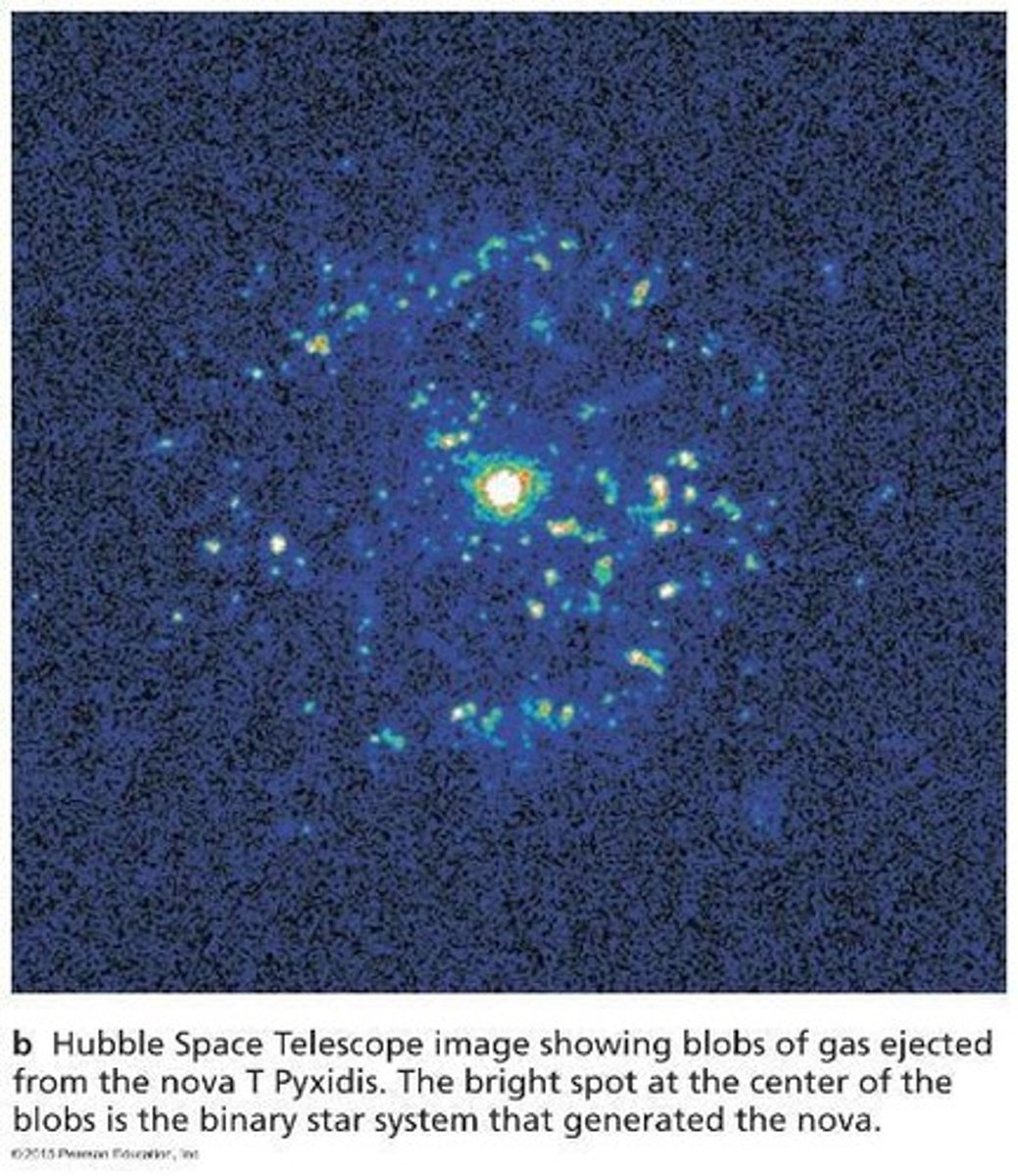
What happens to a white dwarf that accretes enough matter to reach the 1.4MSun limit?
It collapses under gravity, leading to carbon and oxygen fusion throughout the star, resulting in a type Ia supernova explosion.
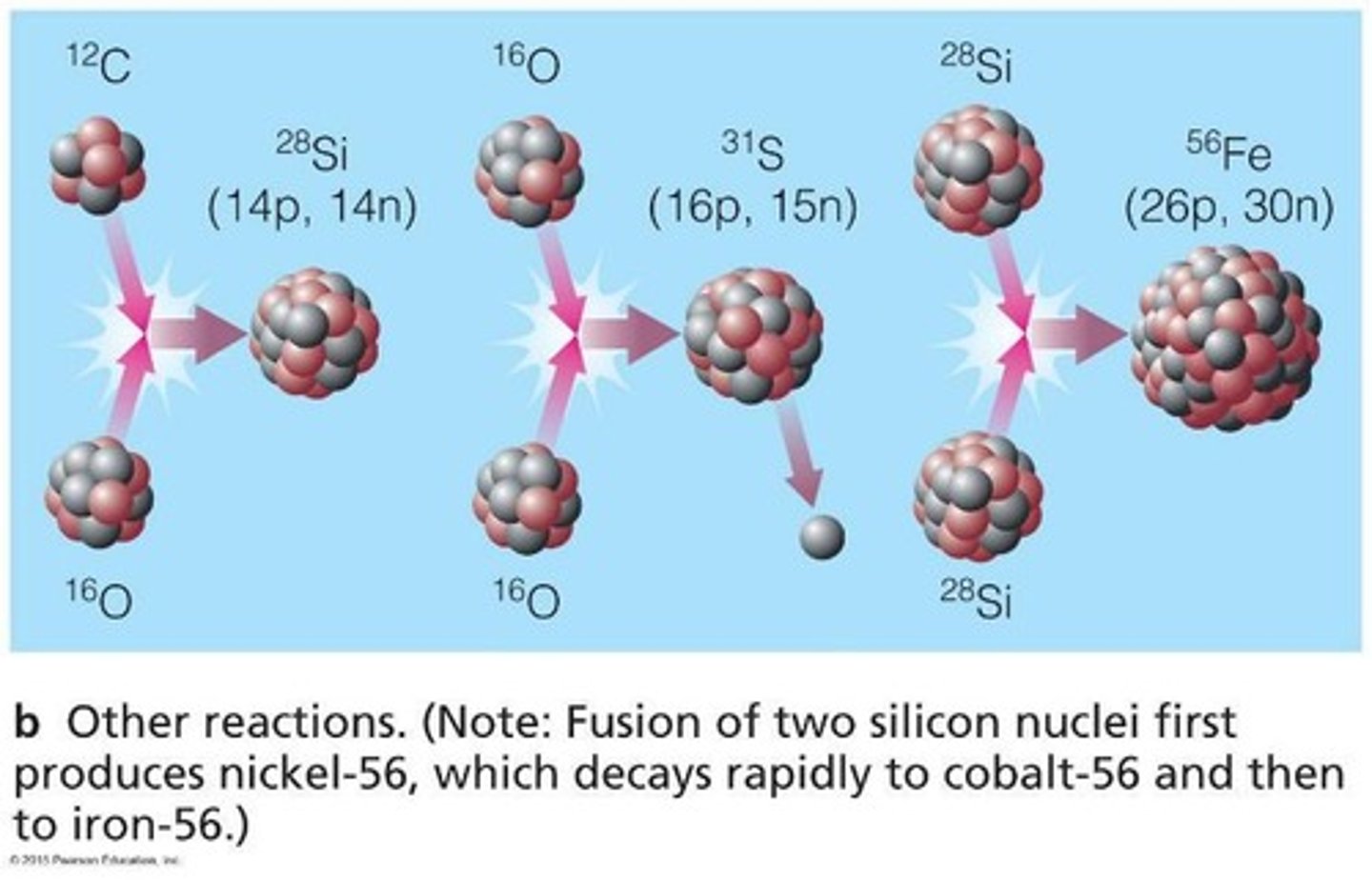
What is a type Ia supernova?
An explosion that occurs in a binary system consisting of a white dwarf and another star, triggered when the white dwarf reaches the Chandrasekhar limit.
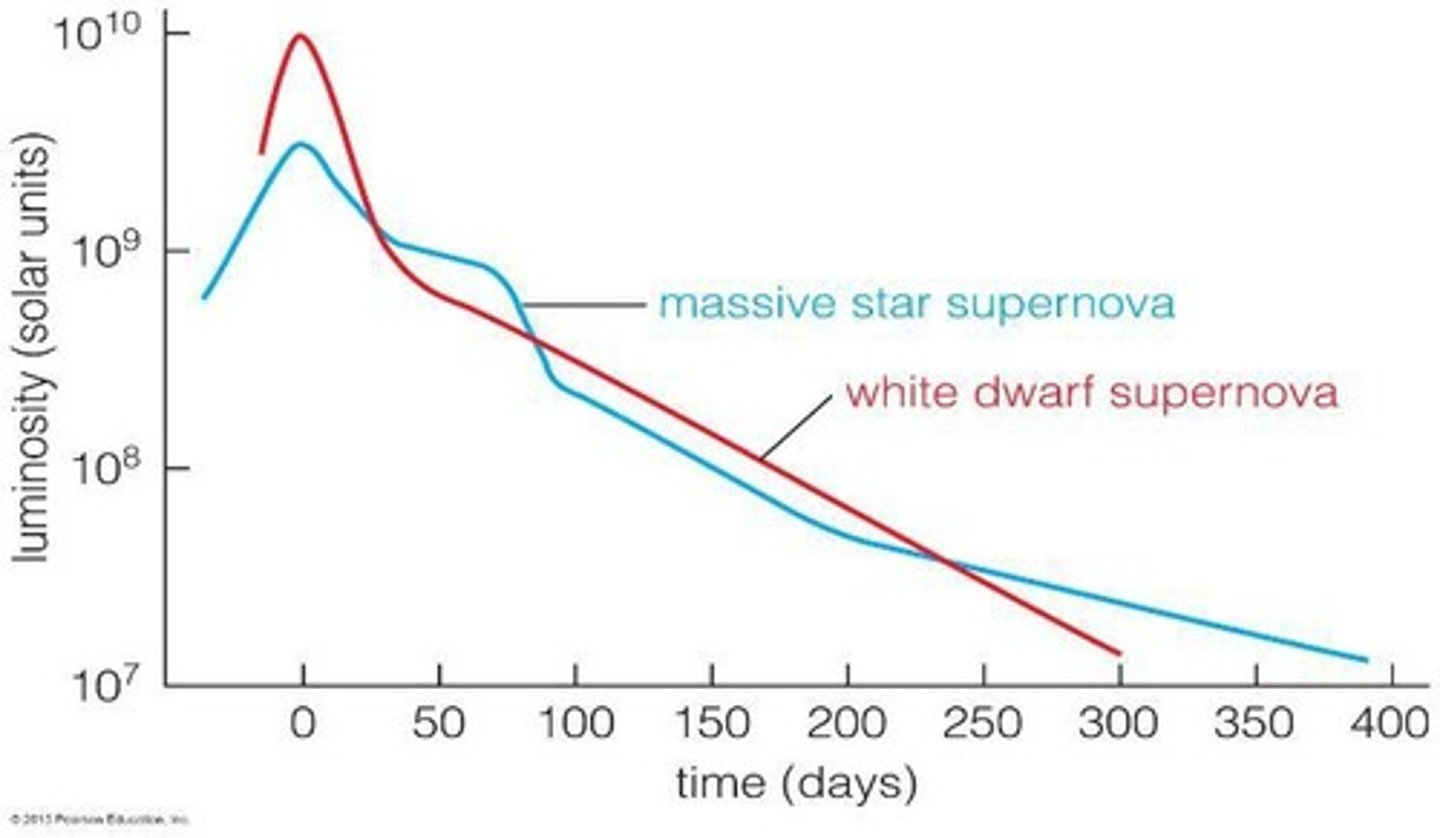
What is the significance of the supernova 2014J?
It is an example of a type Ia supernova, located in the Cigar galaxy (M82), illustrating the explosive end of a white dwarf.
What role does thermal pressure play in stars?
It is the main form of pressure in most stars, depending on the heat content to counteract gravitational collapse.
What happens to the luminosity of a star as it becomes a white dwarf?
The luminosity remains nearly constant initially but decreases as the star cools over billions of years.
What is the relationship between a star's mass and its evolutionary path?
More massive stars evolve differently, often becoming red giants and undergoing mass transfer with companions, affecting their life cycles.
How does the mass loss during a star's evolution affect its core?
As a star loses mass, its core collapses, exposing hotter regions that eventually lead to the formation of a white dwarf.
What is the significance of the Hubble Space Telescope images of stars?
They provide detailed observations of star systems, including the interactions and characteristics of stars at different stages of their life cycles.
What is the process of mass exchange in binary stars?
It occurs when one star transfers material to another, altering their masses and potentially leading to different evolutionary outcomes.
What is the fate of the companion star in the Algol system after the red giant phase?
It will also evolve into a giant and may experience mass transfer back to the original star.
What is the role of friction in accretion disks?
Friction transfers angular momentum outward, heating the disk and allowing for fusion processes to occur.
What does the term 'stellar corpses' refer to?
It refers to the remnants of stars after they have exhausted their nuclear fuel, including white dwarfs, neutron stars, and black holes.
What happens to the core of a white dwarf during a type Ia supernova?
The core undergoes rapid fusion, leading to a catastrophic explosion that disperses the star's material into space.
How far is the closest Type Ia supernova discovered in recent decades?
Approximately 11.5 million light-years from Earth.
What happens to a massive star as it evolves into a supernova?
It undergoes nuclear fusion of heavier elements until it creates an iron core, which cannot fuse further.
What is the Chandrasekhar limit?
The maximum mass (about 1.4 solar masses) that a white dwarf can have before collapsing into a supernova.
What occurs in the core of a massive star just before it becomes a supernova?
The core collapses, leading to a rapid increase in temperature and pressure, resulting in a neutron star formation.
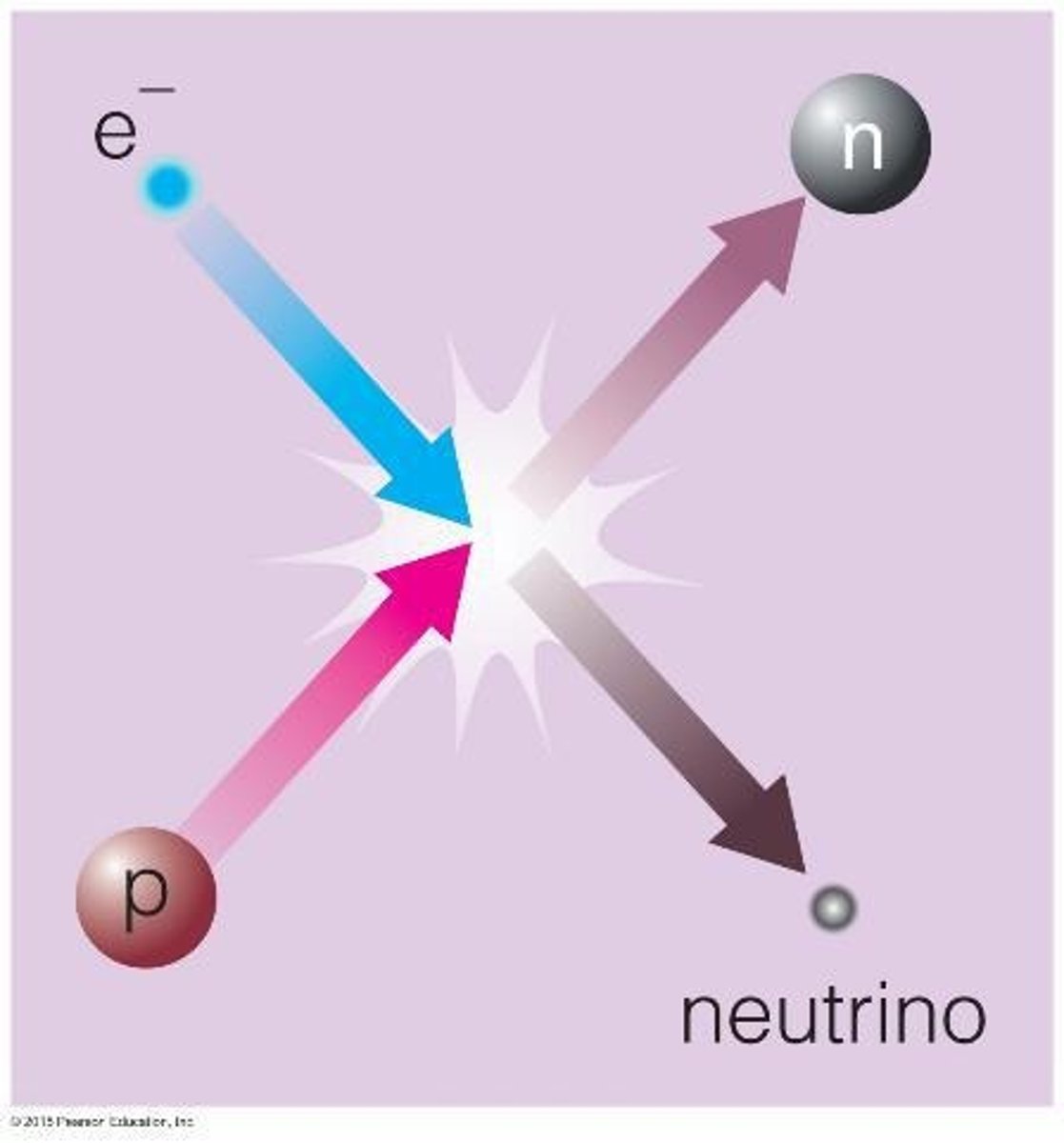
What is a Type II supernova?
A supernova that occurs when a massive star's iron core collapses and rebounds, leading to an explosion.
What is the fate of iron in a massive star's core?
Iron absorbs energy and cannot undergo fusion, leading to core collapse when formed.
What is a neutron star?
The remnant core of a massive star after a Type II supernova, composed primarily of neutrons.
What happens during the supernova explosion?
The core degeneracy pressure fails, electrons combine with protons to form neutrons, causing the outer layers to explode.
What is the structure of a massive star just before its final collapse?
It resembles an onion, with layers of hydrogen, helium, carbon, oxygen, and heavier elements surrounding an iron core.
What is the significance of supernova remnants like the Kepler Supernova?
They provide insights into the processes of stellar evolution and the distribution of elements in the universe.
What is the Crab Nebula?
The remnant of a supernova explosion that occurred in 1054, now observable as a nebula emitting X-rays.
What is SN 1987A known for?
It was a supernova observed in 1987, notable for its remnant structure and ongoing observations of its evolution.
What role does helium play in massive stars?
Helium can fuse with heavier elements at high core temperatures, contributing to the star's energy production.
What happens to the layers of a massive star as it exhausts its nuclear fuel?
The core shrinks and heats, leading to fusion of heavier elements until iron is produced, marking the end of fusion.
What is the energy generation process in massive stars?
Hydrogen fusion occurs in outer shells, with progressively heavier elements fusing in inner layers, generating energy.
What are the observable effects of a supernova explosion?
Supernovae can outshine entire galaxies and produce elements like iron, which are dispersed into space.
What is the significance of studying supernovae?
They help scientists understand stellar evolution, nucleosynthesis, and the dynamics of the universe.
What causes the bright spots observed in the ring of a supernova?
High-speed gas ejected by the supernova collides with the ring, heating it and causing it to glow.
What do the bright spots in a supernova ring indicate?
They suggest that material from the supernova is colliding with narrow, inward-projecting columns of gas in the ring.
What is the significance of studying bright spots in a supernova?
Astronomers can determine the composition of the ring and learn about the nuclear processes that build heavy elements inside massive stars.
What does the light curve of SN 1987A show?
It shows a change in brightness over time, with a slowing rate of decline between days 40 and 500 due to energy from newly formed radioactive elements.
How does a neutron star maintain its structure against gravity?
The degeneracy pressure of neutrons supports the neutron star against gravitational collapse.
What size is a neutron star comparable to?
A neutron star is about the same size as a small city.
How were neutron stars first discovered?
In 1967, Jocelyn Bell detected regular pulses of radio emission from a spinning neutron star, identified as a pulsar.
What is a pulsar?
A pulsar is a type of neutron star that emits radiation along a magnetic axis not aligned with its rotation axis.
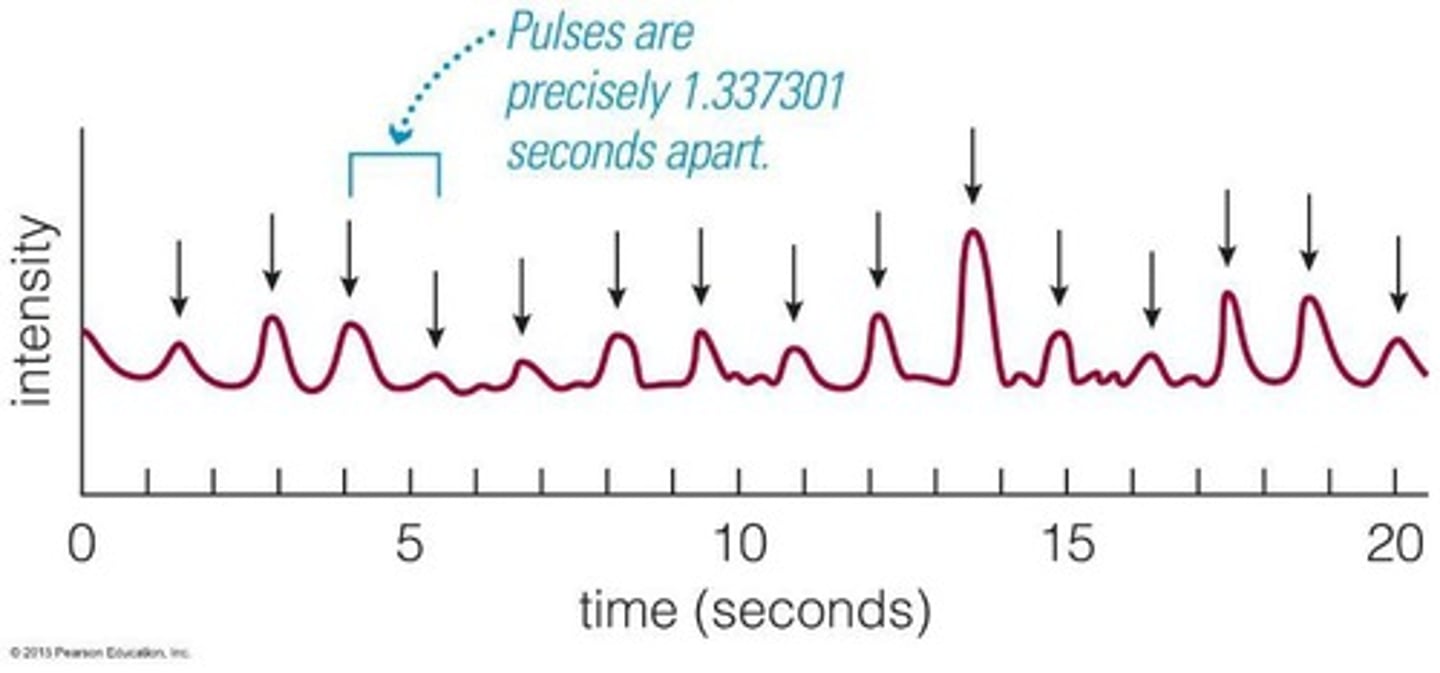
How does the lighthouse model relate to pulsars?
The lighthouse model illustrates how beams of radiation from a pulsar can create pulses of emission as the star rotates.
What is a gamma-ray burst?
A gamma-ray burst is a brief but intense burst of gamma rays from space, first detected in the 1960s.
What are the two types of gamma-ray bursts?
Long-duration bursts, typically associated with supernova explosions, and short-duration bursts, thought to originate from neutron star mergers.

What is the significance of gamma-ray bursts being isotropic?
They show a uniform distribution across the sky, indicating they are not confined to the plane of the Milky Way.
What is the role of the Compton Gamma-Ray Observatory?
It was deployed to detect gamma-ray bursts and provided data on their positions and energy levels.
What is the relationship between supernovae and gamma-ray bursts?
Some gamma-ray bursts are produced by supernova explosions, particularly long-duration bursts.
What typically causes short-duration gamma-ray bursts?
They are thought to originate from the merger of two neutron stars or a neutron star and a black hole.
What is the Swift spacecraft's function?
Swift detects gamma-ray bursts and can automatically reorient itself to observe them, having detected over a thousand bursts since its launch.
What is the significance of the afterglow observed in gamma-ray bursts?
The afterglow provides information about the burst's origin and the environment in which it occurred.
What does the term 'degeneracy pressure' refer to in the context of neutron stars?
It refers to the quantum mechanical pressure that arises from the Pauli exclusion principle, preventing neutrons from occupying the same space.
How does the brightness of a supernova relate to its magnitude?
In the magnitude scale, a larger magnitude indicates a dimmer object, meaning that as a supernova fades, its magnitude increases.
What is the Crab Nebula known for in relation to pulsars?
It contains a pulsar that emits radiation at a rate of 30 pulses per second.
What is the significance of the jets observed from pulsars?
They provide insights into the pulsar's rotation and the energetic processes occurring in its vicinity.
What does the term 'beaming' refer to in gamma-ray bursts?
Beaming refers to the focused emission of gamma rays along specific axes, which can lead to observable bursts when aligned with Earth.
What is the relationship between neutron stars and black holes?
Neutron stars can merge with black holes, potentially leading to short-duration gamma-ray bursts.
What happens to stars during their middle age on the main sequence?
Stars become relatively stable, fusing hydrogen to helium, while gradually becoming hotter and brighter.
What characterizes high-mass stars?
High-mass stars have a mass greater than 8 solar masses (MSun).
What is a brown dwarf?
A brown dwarf never starts nuclear fusion and emits infrared light due to residual heat from contraction.
What is the lifespan of red dwarfs?
Red dwarfs have the lowest core temperature and fuse hydrogen very slowly, lasting at least one trillion years.
What occurs in fully convective stars?
In fully convective stars, hot helium rises to the outer layers while cool hydrogen sinks to the core, leading to complete hydrogen fusion.
What happens when a star exhausts hydrogen in its core?
The core contracts and heats up, initiating hydrogen fusion in a shell around the core.
What is the 'broken thermostat' phenomenon in stars?
It occurs when the core contracts and the fusion rate increases in the shell, causing the core to contract further instead of stabilizing.
What is the triple-alpha process?
The triple-alpha process is when three helium nuclei combine to form carbon, and some carbon can fuse with another helium nucleus to form oxygen.
What happens during a helium flash?
The core temperature rises rapidly, causing a surge in helium fusion until thermal pressure stabilizes the core.
What is observed after helium fusion begins in a star?
The star's outer layers shrink and become less luminous, while it may expand and become a supergiant.
What are the stages of a star's evolution after the main sequence?
A star becomes larger, redder, and more luminous after its main sequence phase.
What happens to a low-mass star after double shell fusion?
It ejects hydrogen and helium into space as a planetary nebula, leaving behind a white dwarf.
What is the significance of the H-R diagram in stellar evolution?
The H-R diagram shows the relationship between a star's luminosity and temperature, indicating its evolutionary stage.
What defines the mass range of intermediate-mass stars?
Intermediate-mass stars have a mass between 2 and 8 solar masses.
How does a low-mass star's core behave during helium fusion?
The core remains stable and does not shrink or grow during helium core fusion.
What is the fate of a star after exhausting its helium core?
The star will undergo further fusion in shells and eventually become a giant again before dying.
What is the luminosity of low-mass stars compared to other types?
Low-mass stars are the dimmest of all stars due to their low core temperatures and slow fusion rates.
What happens to the core of a star during the transition to helium fusion?
The core must shrink and heat to a much greater temperature for helium fusion to begin.
What is the evolutionary track of a star like the Sun on the H-R diagram?
It evolves from the main sequence to a red giant, then undergoes a helium flash, and eventually becomes a giant again.
What is the role of degeneracy pressure in low-mass stars?
Degeneracy pressure supports the core during the helium flash, allowing rapid temperature increases.
What happens to a star's core after it ejects hydrogen and helium as a planetary nebula?
The core left behind becomes a white dwarf.
What is the Ant Nebula also known as?
Menzel 3.
How far is the Ant Nebula from the Sun?
About 3000 light-years.
What is the significance of the Ring Nebula (M57)?
It is one of the best-known planetary nebulae, located about 2000 light-years away in the constellation of Lyra.
What is the temperature of the central star in the Ring Nebula?
About 120,000 °C.
What does the color coding in the Ring Nebula's image represent?
Red corresponds to ionized nitrogen, green to oxygen, and blue to hot helium.
What characterizes the butterfly nebula (M2-9)?
It shows mass ejected preferentially in two opposite directions from a binary star system.
How long ago did the stellar outburst that formed the butterfly nebula occur?
About 1200 years ago.
What is the distance of the planetary nebula NGC 6751 from Earth?
About 6500 light-years.
What does the blue region in NGC 6751 indicate?
It marks the hottest gas forming a ring around the central star.
What is the diameter of the nebula NGC 6751 compared to our solar system?
About 600 times larger.
What does the image of NGC 7027 show regarding mass loss?
It shows several stages of mass loss, including concentric shells and irregular ejections.
What is the primary shape of many planetary nebulae attributed to?
The presence of a thick torus (doughnut-shaped disk) of gas surrounding a hot central star.
What viewing direction leads to a nearly circular appearance of a planetary nebula?
Viewing along the direction of the stellar wind flow.
What is the suggested cause for the torus around many central stars in planetary nebulae?
Many central stars are likely close binary stars.
What limits fusion in a low-mass star at the end of its life?
The core temperature never grows hot enough for fusion of heavier elements.
What supports a white dwarf against gravity?
Degeneracy pressure.